Submitted:
04 December 2023
Posted:
05 December 2023
You are already at the latest version
Abstract
Keywords:
1. Introduction
2. Materials and Methods
2.1. The bias-free SEKF soil moisture analysis
2.2. The two-stage bias filter
2.3. Satellite-derived soil moisture observations and pre-processing
2.4. ECland surface model
2.5. The stand-alone surface analysis
2.6. Experiments
2.7. SM and ST validation approach
2.8. Atmospheric validation approach
3. Results
3.1. Internal DA diagnostics
3.2. SM and ST validation
3.3. Atmospheric validation
4. Summary and discussion
Funding
Author Contributions: David Fairbairn, Patricia de Rosnay and Peter Weston
Data Availability Statement
Conflicts of Interest
References
- Dee, D.; Todling, R. Data assimilation in the presence of forecast bias: The GEOS moisture analysis. MWR 2000, 128, 3268–3282. [Google Scholar] [CrossRef]
- Hahn, S.; Wagner, W.; Steele-Dunn, S.; Vreugdenhil, M.; Melzer, T. Improving ASCAT soil moisture retrievals with an enhanced spatially variable vegetation parameterization. IEEE Transactions on Geoscience and Remote Sensingl 2021, 59, 8241–8256. [Google Scholar] [CrossRef]
- Harris, B.; Kelly, G. A satellite radiance-bias correction scheme for data assimilation. Quart. J. Roy. Meteor. Soc. 2001, 127, 1453–1468. [Google Scholar] [CrossRef]
- Dee, D.; Uppala, S. Variational bias correction of satellite radiance data in the ERA-Interim reanalysis. Quart. J. Roy. Meteor. Soc. 2009, 135, 1830–1841. [Google Scholar] [CrossRef]
- Francis, D.; Fowler, A.; Lawless, A.; Eyre, J.; Migliorini, S. The effective use of anchor observations in variational bias correction in the presence of model bias. Quart. J. Roy. Meteor. Soc. 2023, 149, 1789–1809. [Google Scholar] [CrossRef]
- Crow, W.; Berg, A.; Cosh, M.; Loew, A.; Mohanty, B.; Panciera, R.; de Rosnay, P.; Ryu, D.; Walker, J. Upscaling sparse ground-based soil moisture observations for the validation of coarse-resolution satellite soil moisture products. Reviews of Geophysics, 2012, 50, RG2002. [Google Scholar] [CrossRef]
- Drusch, M.; Wood, E.; Gao, H. Observation operators for the direct assimilation of TRMM microwave imager retrieved soil moisture. Geophys. Res. Lett. 2005, 32, L15403. [Google Scholar] [CrossRef]
- Reichle, R.; Koster, R. Bias reduction in short records of satellite soil moisture. Geophys. Res. Lett. 2004, 31, L19501. [Google Scholar] [CrossRef]
- Scipal, K.; Drusch, M.; Wagner, W. Assimilation of a ERS scatterometer derived soil moisture index in the ECMWF numerical weather prediction system. Advances in water resources 2008, 31(8), 1101–1112. [Google Scholar] [CrossRef]
- de Rosnay, P.; Muñoz-Sabater, J.; Albergel, C.; Isaksen, L.; English, S.; Drusch, M.; Wigneron, J. SMOS brightness temperature forward modelling and long term monitoring at ECMWF. Remote Sensing of Environment 2020, 237, 111424. [Google Scholar] [CrossRef]
- Rodríguez-Fernández, N.; De Rosnay, P.; Albergel, C.; Richaume, P.; Aires, F.; Prigent, C.; Kerr, Y. SMOS Neural Network Soil Moisture Data Assimilation in a Land Surface Model and Atmospheric Impact. Remote Sensing 2019, 11(11), 1334. [Google Scholar] [CrossRef]
- Aires, F.; Weston, P.; de Rosnay, P.; Fairbairn, D. Statistical approaches to assimilate ASCAT soil moisture information—I. Methodologies and first assessment. Quart. J. Roy. Meteor. Soc. 2021, 147, 1823–1852. [Google Scholar] [CrossRef]
- de Rosnay, P.; Drusch, M.; Vasiljevic, D.; Balsamo, G.; Albergel, C.; Isaksen, L. A simplified Extended Kalman Filter for the global operational soil moisture analysis at ECMWF. Quart. J. Roy. Meteor. Soc. 2013, 139, 1199–1213. [Google Scholar] [CrossRef]
- de Rosnay, P.; Browne, P.; de Boisséson, E.; Fairbairn, D.; Hirahara, Y.; Ochi, K.; Schepers, D.; Weston, P.; Zuo, H.; Alonso-Balmaseda, M.; Balsamo, G.; Bonavita, M.; Borman, N.; Brown, A.; Chrust, M.; Dahoui, M.; Chiara, G.; English, S.; Geer, A.; Healy, S.; Hersbach, H.; Laloyaux, P.; Magnusson, L. ; Massart, S.; McNally, A.; Pappenberger, F.; Rabier, F. Coupled data assimilation at ECMWF: current status, challenges and future developments. Quarterly Journal of the Royal Meteorological Society 2022, 148, 2672–2702. [Google Scholar] [CrossRef]
- Dee, D.; Silva, A.D. Data assimilation in the presence of forecast bias. QJRMS 1998, 124, 269–295. [Google Scholar] [CrossRef]
- Chepurin, G.; Carton, J.; Dee, D. Forecast model bias correction in ocean data assimilation. MWR 2005, 133, 1328–1342. [Google Scholar] [CrossRef]
- Keppenne, C.; Rienecker, M.; Kurkowski, N.; Adamec, D. Ensemble Kalman filter assimilation of temperature and altimeter data with bias correction and application to seasonal prediction. Nonlinear Processes Geophys 2005, 12, 491–503. [Google Scholar] [CrossRef]
- Bosilovich, M.; da Silva, A.; Todling, R.; Verter, F. Skin temperature analysis and bias correction in a coupled land–atmosphere data assimilation system. J. Meteor. Soc. Japan 2007, 85A, 205–228. [Google Scholar] [CrossRef]
- De Lannoy, G.; Reichle, R.; Houser, P.; Pauwels, V.; Verhoest, N. Correcting for forecast bias in soil moisture assimilation with the ensemble Kalman filter. Water Resour. Res. 2007, 43, W09410. [Google Scholar] [CrossRef]
- Reichle, R.; Kumar, S.; Mahanama, S.; Koster, R.; Liu, Q. Assimilation of satellite-derived skin temperature observations into land surface models. J. Hydrometeor. 2010, 11, 1103–1122. [Google Scholar] [CrossRef]
- Pauwels, V.; De Lannoy, G.; Hendricks Franssen, H.J.; Vereecken, H. Simultaneous estimation of model state variables and observation and forecast biases using a two-stage hybrid Kalman filter. HESS 2013, 17, 3499–3521. [Google Scholar] [CrossRef]
- Draper, C.; Reichle, R.; Lannoy, G.D.; Scarino, B. A dynamic approach to addressing observation-minus-forecast bias in a land surface skin temperature data assimilation system. J. Hydrometeor. 2015, 16. [Google Scholar] [CrossRef]
- ECMWF. IFS documentation CY47R3. ECMWF website. ECMWF, 2021. [Available online at https://www.ecmwf.int/en/forecasts/documentation-and-support/changes-ecmwf-model/ifs-documentation.].
- Ide, K.; Courtier, P.; Ghil, M.; Lorenc, A.C. Unified Notation for Data Assimilation Operational Sequential and Variational. J. Met. Soc. Japan 1997, 75, 181–189. [Google Scholar] [CrossRef]
- Bonavita, M.; Isaksen, L.; Hólm, E. On the use of EDA background error variances in the ECMWF 4D–Var. Quart. J. Roy. Meteor. Soc. 2015, 138(667), 1540–1559. [Google Scholar] [CrossRef]
- Wagner, W.; Lemoine, G.; Rott, H. A Method for Estimating Soil Moisture from ERS Scatterometer and Soil Data. Remote sensing of Environment 1999, 70, 191–207. [Google Scholar] [CrossRef]
- Wagner, W.; Naeimi, V.; Hasenauer, S.; Scipal, K.; Bonekamp, H.; Figa, J.; Anderson, C. Initial soil moisture retrievals from the METOP-A Advanced Scatterometer (ASCAT). GRL 2007, 34(20). [CrossRef]
- Draper, C.; Mahfouf, J.F.; Walker, J. An EKF assimilation of AMSR-E soil moisture into the ISBA land surface scheme. J. Geophys. Res 2009, 114, D20104. [Google Scholar] [CrossRef]
- Barbu, A.; Calvet, J.; Mahfouf, J.; Lafont, S. Integrating ASCAT surface soil moisture and GEOV1 leaf area index into the SURFEX modelling platform: a land data assimilation application over France. Hydrol. Earth Syst. Sci. 2014, 18(1), 173–192. [Google Scholar] [CrossRef]
- Fairbairn, D.; de Rosnay, P.; Browne, P. The new stand-alone surface analysis at ECMWF: Implications for land–atmosphere DA coupling. J. Hydrometeor. 2019, 20(10), 2023–2042. [Google Scholar] [CrossRef]
- Rodríguez-Fernández, N.; Sabater, J.M.; Richaume, P.; De Rosnay, P.; Kerr, Y.; Albergel, C.; Drusch, M.; Mecklenburg, S. SMOS near-real-time soil moisture product: processor overview and first validation results. Hydrol. Earth Syst. Sci. 2017, 21, 5201–5216. [Google Scholar] [CrossRef]
- Moré, J. The Levenberg-Marquardt algorithm: Implementation and theory. In Numerical Analysis. Springer: Berlin/Heidelberg, Germany, 1978. pp. 105–116.
- Boussetta, S.; Balsamo, G.; Arduini, G.; Dutra, E.; McNorton, J.; Choulga, M.; Agustí-Panareda, A.; Beljaars, A.; Wedi, N.; Munõz-Sabater, J.; De Rosnay, P. ECLand: The ECMWF land surface modelling system. Atmosphere 2021, 12(6), 723. [Google Scholar] [CrossRef]
- Balsamo, G.; Beljaars, A.; Scipal, K.; Viterbo, P.; van den Hurk, B.; Hirschi, M.; Betts, A. A Revised Hydrology for the ECMWF Model: Verification from Field Site to Terrestrial Water Storage and Impact in the Integrated Forecast System. J. Hydrometeor. 2009, 10, 623–643. [Google Scholar] [CrossRef]
- Loveland, T.R.; Reed, B.; Brown, J.; Ohlen, D.; Zhu, Z.; Youing, L.; Merchant, J. Development of a Global Land Cover Characteristics Database and IGB6 DISCover from the 1km AVHRR Data. Int. J. Remote Sens. 2000, 21, 1303–1330. [Google Scholar] [CrossRef]
- Boussetta, S.; Balsamo, G.; Beljaars, A.; Kral, T.; Jarlan, L. Impact of a satellite–derived leaf area index monthly climatology in a global numerical weather prediction model. Int. J. Remote Sens. 2013, 34(9-10), 3520–3542. [CrossRef]
- Richards, L. Capillary conduction of liquids in porous medium. Physics 1 1931, p. 318–333. [CrossRef]
- Arduini, A.; Balsamo, G.; Dutra, E.; Day, J.; Sandy, I.; Boussetta, S.; Haiden, T. Impact of a multi-layer snow scheme on near-surface weather forecasts. JAMES 2019, 11(12), 4687–4710. [Google Scholar] [CrossRef]
- Hersbach, H.; Bell, B.; Berrisford, P.; Hirahara, S.; Horányi, A.; Muñoz-Sabater, J.; Nicolas, J.; Peubey, C.; Radu, R.; Schepers, D.; Simmons, A. The ERA5 global reanalysis. QJRMS 2020, 146(730), 1999–2049. [Google Scholar] [CrossRef]
- Haseler, J. Early–delivery suite. Technical Memorandum 454. ECMWF, 2004. [Available online at URL: http://www.ecmwf.int/publications/.].
- Dorigo, W.; Wagner, W.; Hohensinn, R.; Hahn, S.; Paulik, C.; Xaver, A.; Gruber, A.; Drusch, M.; Mecklenburg, S.; Oevelen, P.; Robock, A. The International Soil Moisture Network: a data hosting facility for global in situ soil moisture measurements. Hydrol. Earth Syst. Sci. 2011, 15, 1675–1698. [Google Scholar] [CrossRef]
- Bell, J.E.; Palecki, M.A.; Baker, C.; Collins, W.; Lawrimore, J.; Leeper, R.; Hall, M.; Kochendorfer, J.; Meyers, T.; Wilson, T.; Diamond, H. U.S. Climate Reference Network soil moisture and temperature observations. J. Hydrometeor. 2013, 14, 977–988. [Google Scholar] [CrossRef]
- Calvet, J.; Fritz, N.; Froissard, F.; Suquia, D.; Petitpa, A.; Piguet, B. In situ soil moisture observations for the CAL/VAL of SMOS: the SMOSMANIA network. Geoscience and Remote Sensing Symposium, IGARSS 2007. IEEE International, 2007, Vol. 16 (3), pp. 1293–1314.
- Martinez-Fernández, J.; Caballos, A. Mean soil moisture estimation using temporal stability analysis. J. Hydrol. 2005, 312, 28–38. [Google Scholar] [CrossRef]
- Zacharias, S.; Bogena, H.; Samaniego, L.; Mauder, M.; Fuß, R.; Pütz, T.; Frenzel, M.; Schwank, M.; Baessler, C.; Butterbach-Bahl, K.; Bens, O.; Borg, E.; Brauer, A.; Dietrich, P.; Hajnsek, I.; Helle, G.; Kiese, R.; Kunstmann, H.; Klotz, S.; Munch, J.; Papen, H.; Priesack, E.; Schmid, H.P.; Steinbrecher, R.; Rosenbaum, U.; Teutsch, G.; Vereecken, H. A Network of Terrestrial Environmental Observatories in Germany. Vadose Zone J. 2011, 10, 955–973. [Google Scholar] [CrossRef]
- Smith, A.; Walker, J.; Young, R.; Ellett, K.; Pipunic, R.; Grayson, R.; Siriwardena, L.; Chiew, F.; Richter, H. The Murrumbidgee soil moisture monitoring network data set. Water Resour. Res. 2012, 48, W07701. [Google Scholar] [CrossRef]
- Albergel, C.; Dorigo, W.; Reichle, R.; Balsamo, G.; De Rosnay, P.; Muñoz Sabater, J.; Isaksen, L.; De Jeu, R.; Wagner, W. Skill and global trend analysis of soil moisture from reanalyses and microwave remote sensing. J. Hydrometeor. 2013, 14, 1259–1277. [Google Scholar] [CrossRef]
- Draper, C.; Reichle, R.; De Lannoy, G.; Liu, Q. Assimilation of passive and active microwave soil moisture retrievals. Geophys. Res. Lett. 2012, 39. [Google Scholar] [CrossRef]
- Reichle, R.; De Lannoy, G.; Liu, Q.; Ardizzone, J.; Colliander, A.; Conaty, A.; Crow, W.; Jackson, T.; Jones, L.; Kimball, J.; Koster, R. Assessment of the SMAP Level-4 surface and root-zone soil moisture product using in situ measurements. J. Hydrometeor. 2017, 18, 2621–2645. [Google Scholar] [CrossRef]
- Dorigo, W.; Xaver, A.; Vreugdenhil, M.; Gruber, A.; Hegyiova, A.; Sanchis-Dufau, A.; Zamojski, D.; Cordes, C.; Wagner, W.; Drusch, M. Global automated quality control of in situ soil moisture data from the International Soil Moisture Network. Vadose Zone J. 2013, 12. [Google Scholar] [CrossRef]
- Entekhabi, D.; Reichle, R.; Koster, R.; Crow, W. Performance metrics for soil moisture retrievals and application requirements. J. Hydrometeor. 2010, 11, 832–840. [Google Scholar] [CrossRef]
- Geer, A. Significance of changes in medium–range forecast scores. Tellus A 2016, 68, 30229. [Google Scholar] [CrossRef]
- Desroziers, G.; Berre, L.; B. Chapnik, B.P.P. Diagnosis of observation, background and analysis-error statistics in observation space. Quart. J. Roy. Meteor. Soc. 2005, 131, 3385–3396. [Google Scholar] [CrossRef]
- Hahn, S.; Wagner, W.; Alves, O.; Sanjeevamurthy, P.M.; Vreugdenhil, M.; Melzer, T. Metop ASCAT soil moisture trends: Mitigating the effects of long-term land cover changes. EGU General Assembly 2023, Vienna, Austria. EGU23-16205, 2023. [CrossRef]
- Montzka, C.; Moradkhani, H.; Weihermuller, L.; Canty, M.; Frassen, H.H.; Vereecken, H. Hydraulic parameter estimation by remotely-sensed top soil moisture observations with the particle filter. J. Hydrol. 2011, 399, 410–421. [Google Scholar] [CrossRef]
- Kumar, S.; Reichle, R.; Harrison, K.; Peters-Lidard, C.; Yatheendradas, S.; Santanello, J. A comparison of methods for a priori bias correction in soil moisture data assimilation. Water Resources Research 2012, 48 (3). [CrossRef]
- Abramowitz, G. On the predictability of turbulent fluxes from land: PLUMBER2 MIP experimental description and preliminary results. Manuscript in preparation.
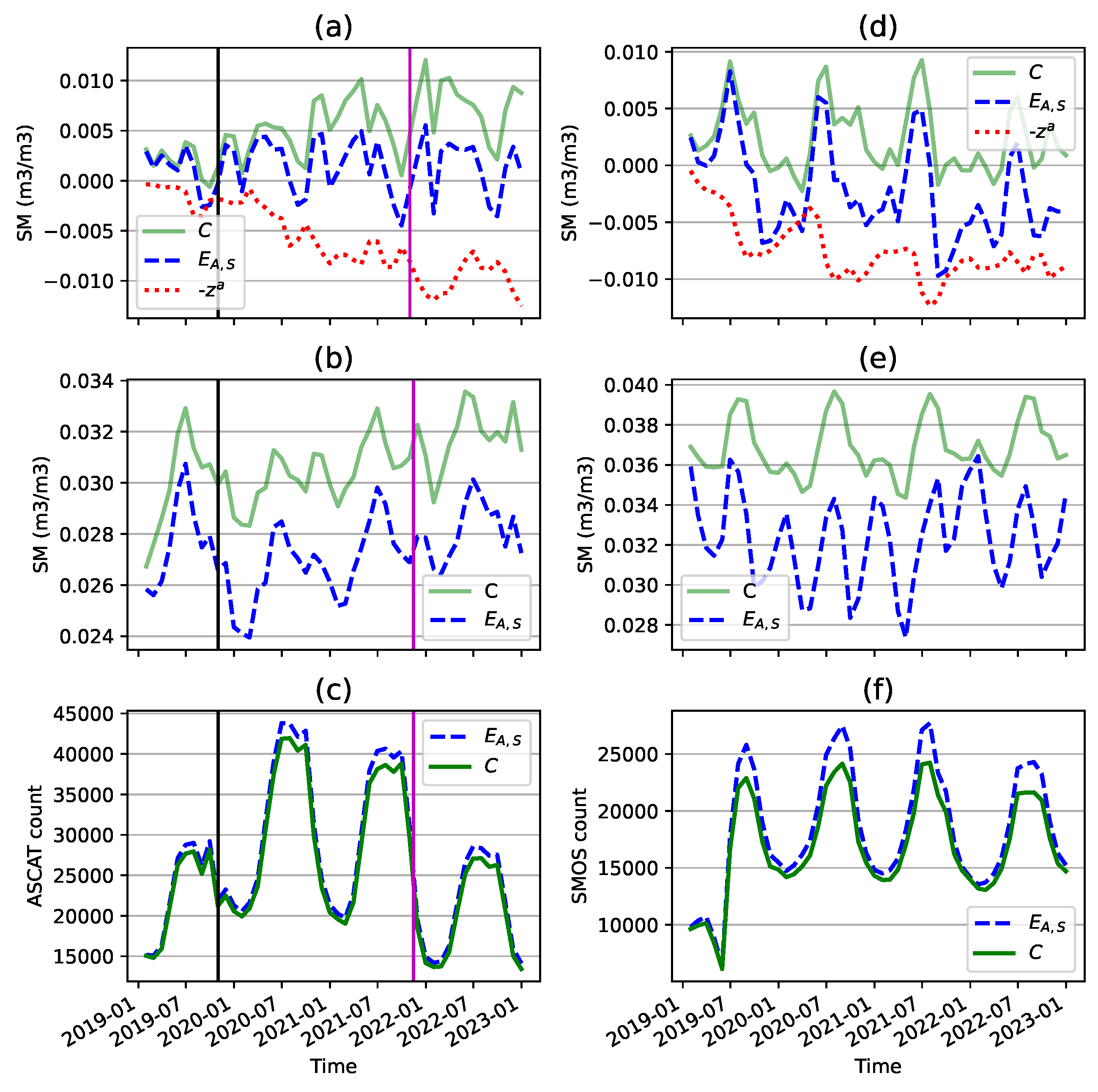
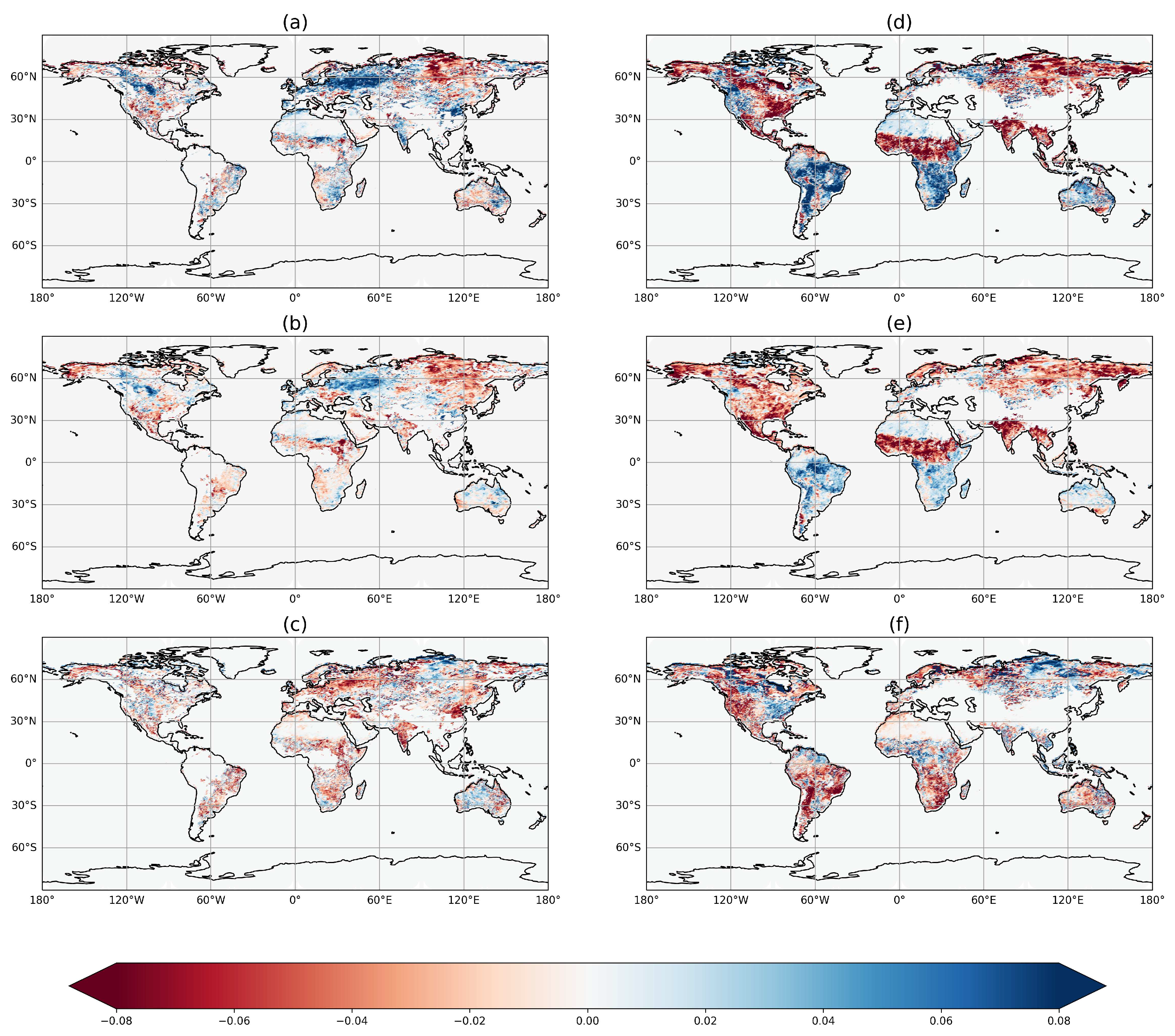

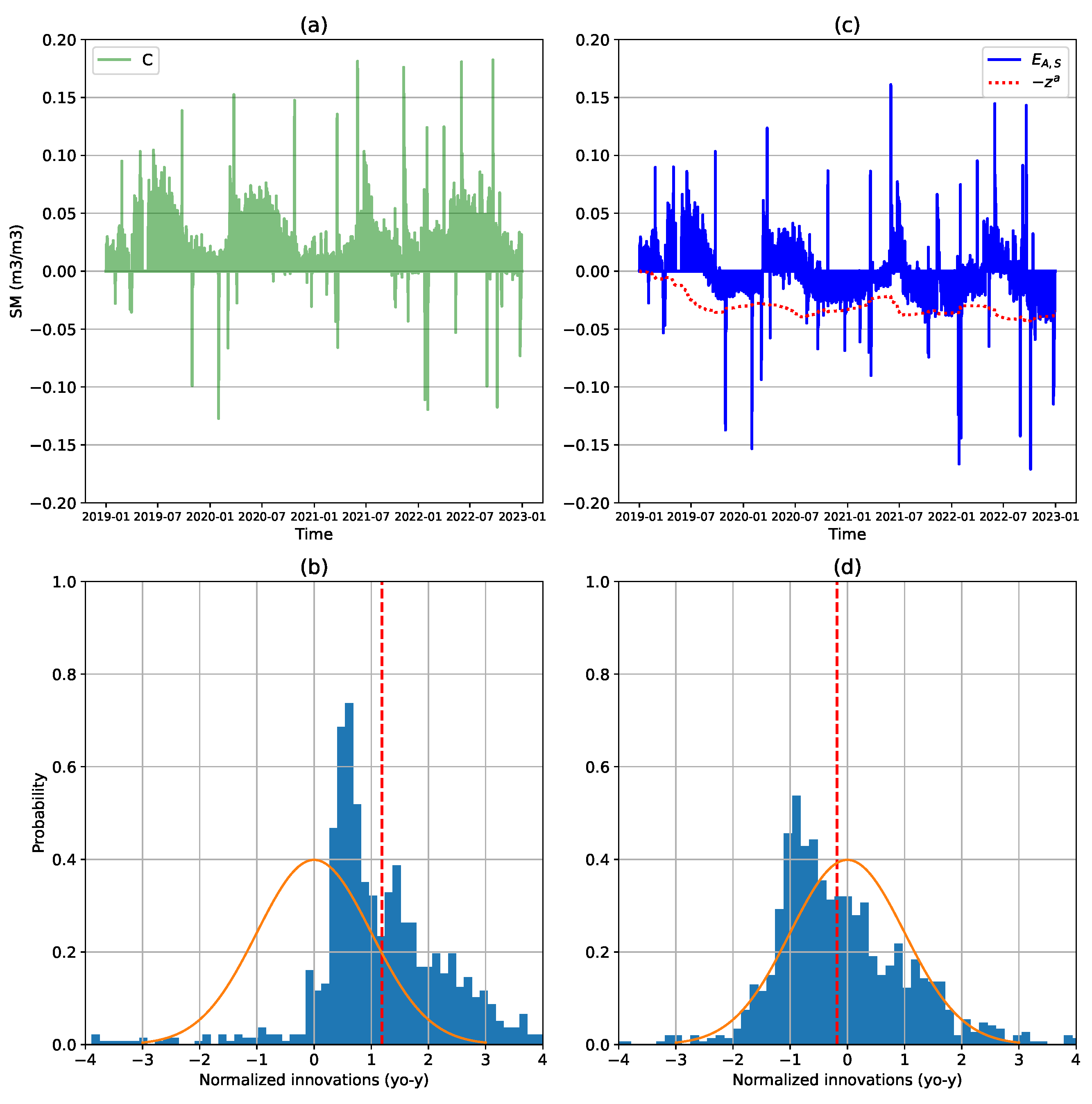
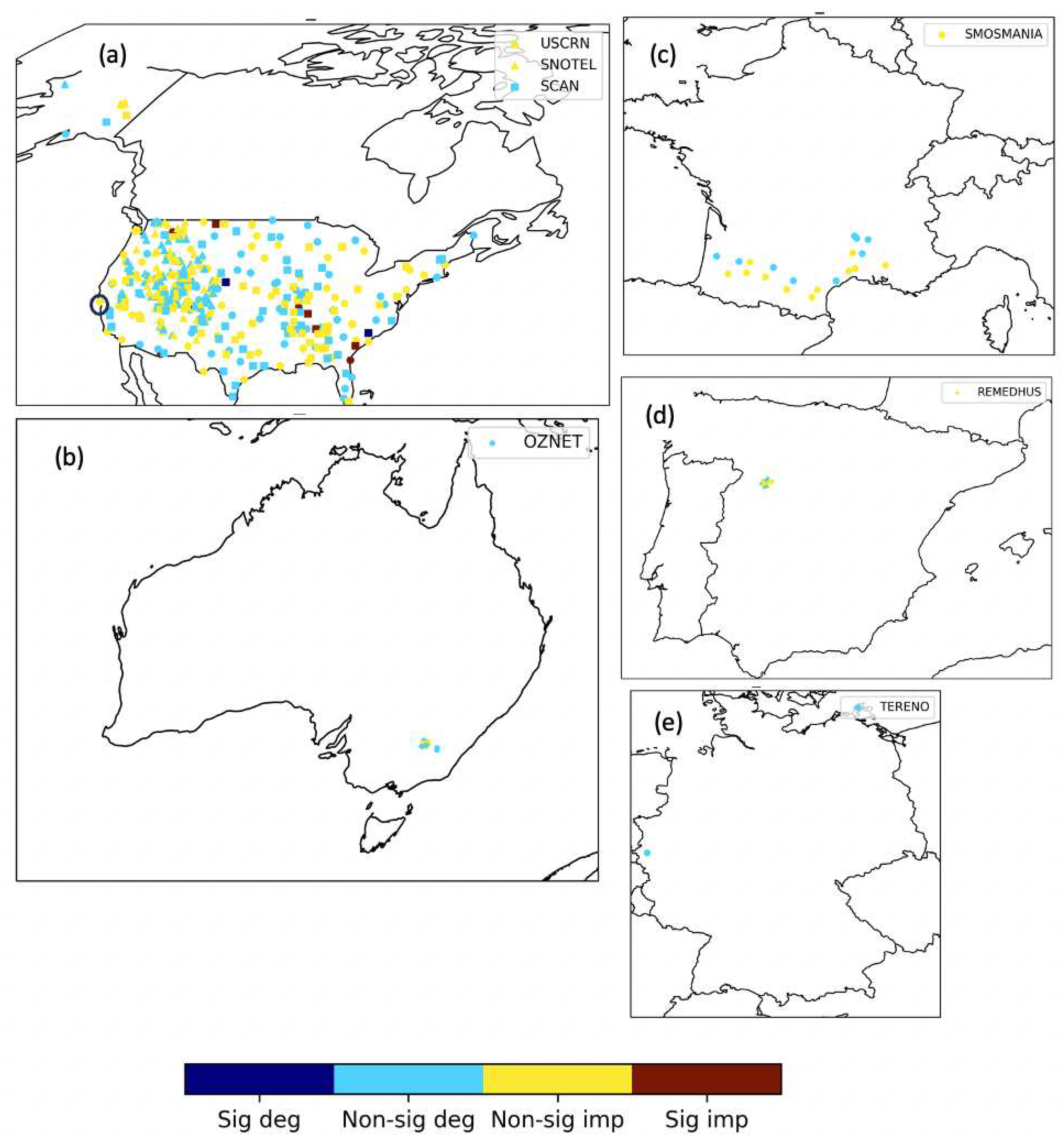
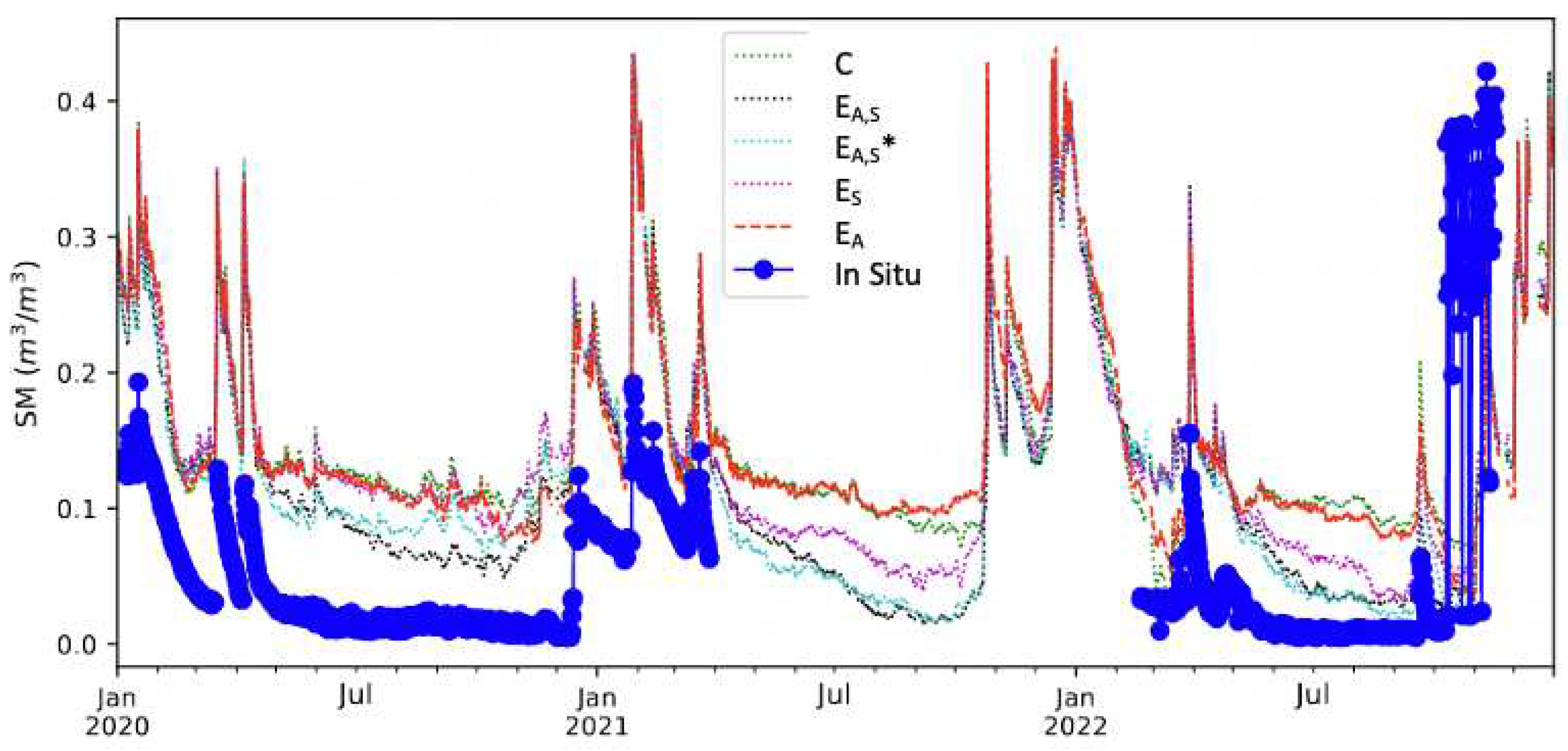

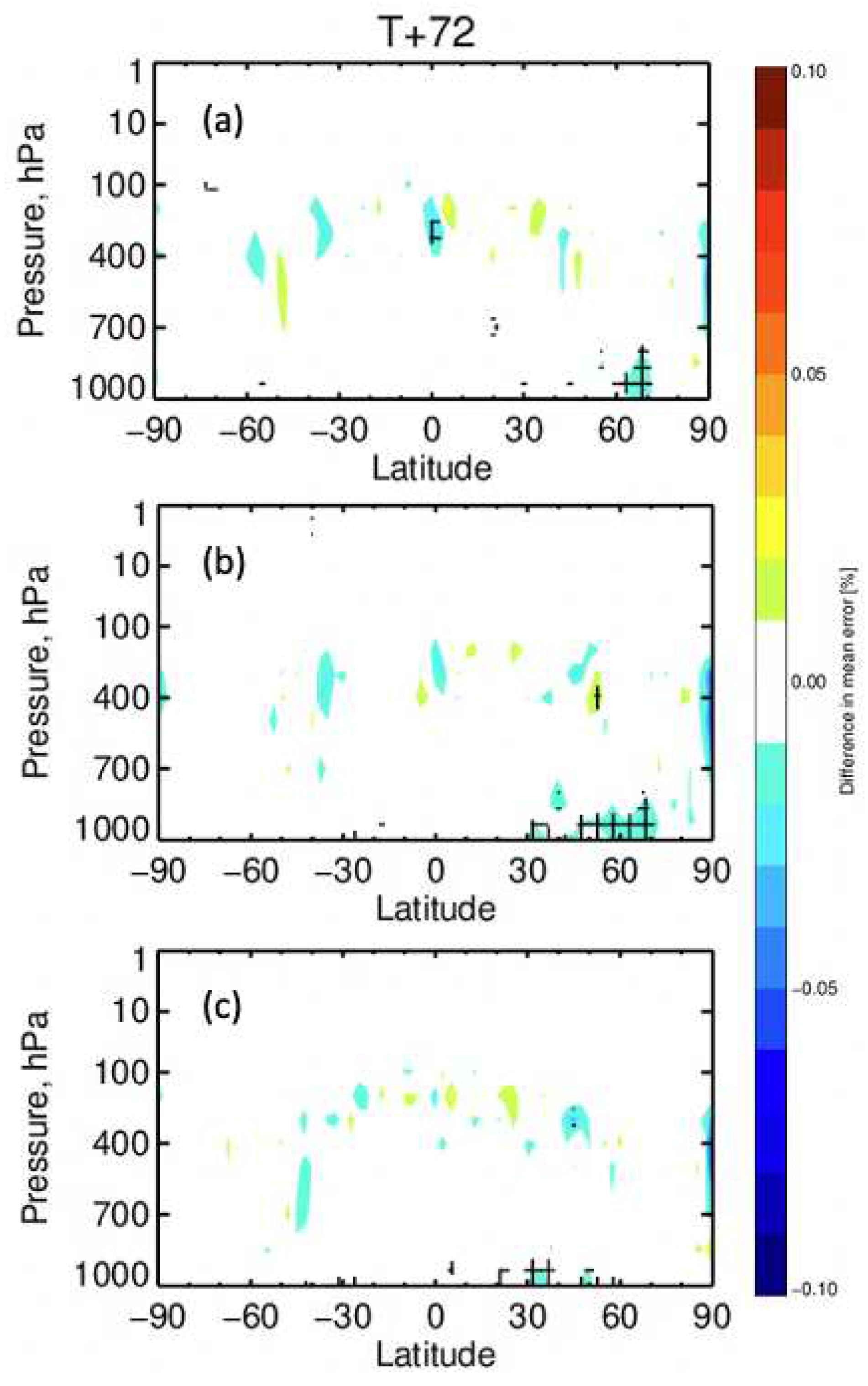
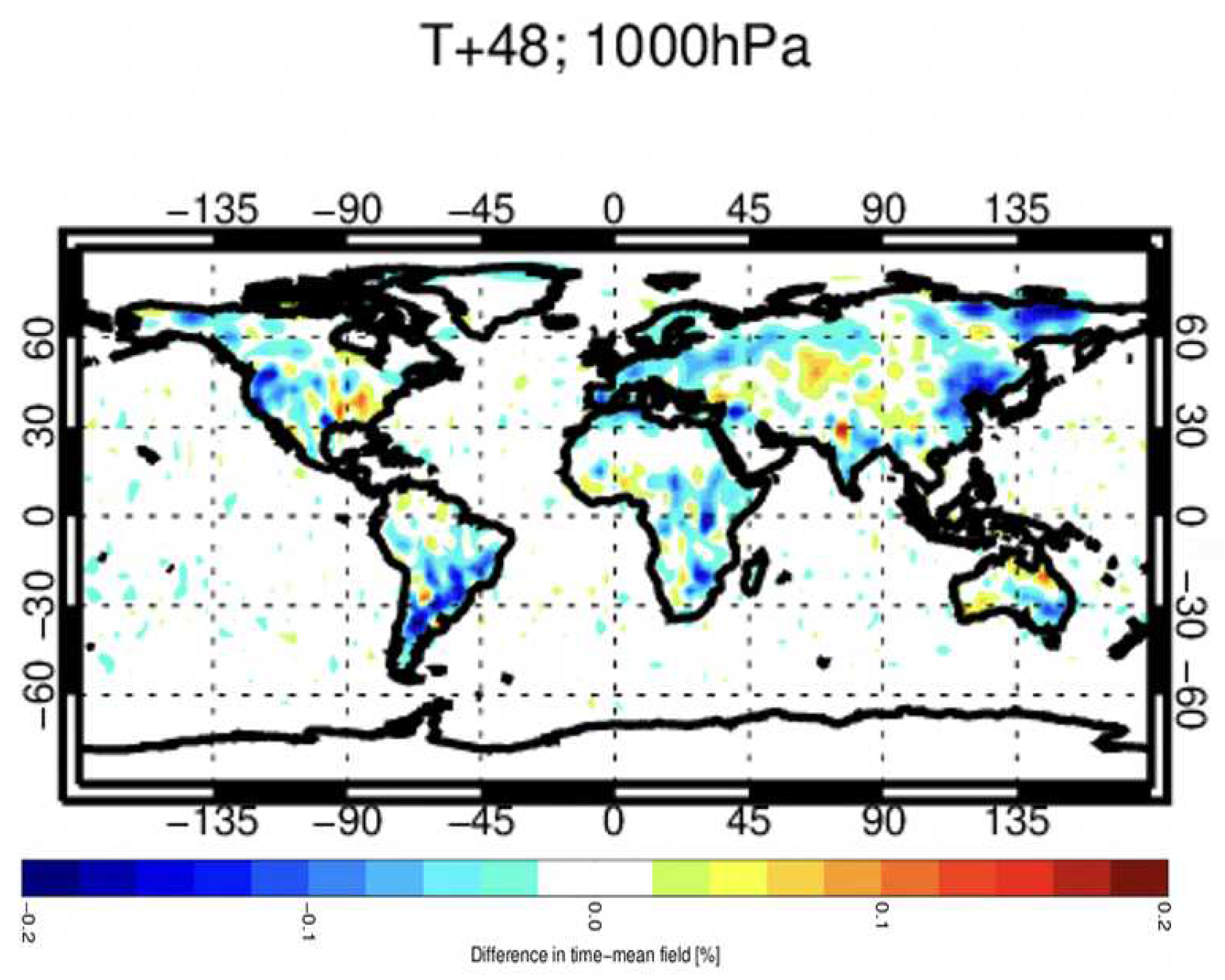
| Experiment | C | ||||
|---|---|---|---|---|---|
| ASCAT adaptive BC | False | True | False | True | True |
| SMOS adaptive BC | False | False | True | True | True |
| ASCAT seasonal rescaling | True | True | True | True | False |
| Name | Reference type | Vertical depths/levels | Spatial res. | Num. of stations |
|---|---|---|---|---|
| SMOSMANIA | In situ SM/ST | 5, 10, 20, 30 cm depth | Point-wise | 20 stations /France |
| SCAN | In situ SM/ST | 5, 10, 20, 50, 100 cm depth | Point-wise | 133 stations/US |
| USCRN | In situ SM/ST | 5, 10, 20, 50, 100 cm depth | Point-wise | 106 stations/US |
| SNOTEL | In situ SM/ST | 5, 10, 20, 50 cm depth | Point-wise | 292 stations/US |
| REMEDHUS | In situ SM/ST | 5 cm depth | Point-wise | 15 stations/Spain |
| OZNET | In situ SM/ST | 4, 15, 45 and 75 cm depth | Point-wise | 13 stations/Australia |
| TERENO | In situ SM/ST | 5, 20 and 50 cm depth | Point-wise | 1 station/Germany |
| ECMWF* | Air temp analysis | 137 levels (1-1000 hPa) | 31 km | Global analysis |
| ECMWF* | Air RH analysis | 137 levels (1-1000 hPa) | 31 km | Global analysis |
| Variable | C | ||||
|---|---|---|---|---|---|
| ASCAT SM depar. () | 5 | 1 | 5 | 1 | -1 |
| Absolute ASCAT SM depar. () | 26 | 23 | 26 | 23 | 29 |
| SMOS SM depar. () | 2 | 2 | -3 | -3 | -3 |
| Absolute SMOS SM depar. () | 37 | 37 | 32 | 32 | 32 |
| SSM inc. () | 16 | 13 | 14 | 10 | 12 |
| Absolute SSM inc. () | 204 | 202 | 201 | 200 | 202 |
| RZSM inc. () | 4 | 4 | 3 | 3 | 3 |
| Absolute RZSM inc. () | 98 | 98 | 97 | 97 | 97 |
| Global mean Score | C | ||||
|---|---|---|---|---|---|
| SSM R anomaly (-) | 0.439 | 0.439 | 0.441 | 0.441 | 0.441 |
| SSM UbRMSE () | 0.063 | 0.063 | 0.063 | 0.063 | 0.063 |
| SSM bias () | 0.065 | 0.065 | 0.065 | 0.065 | 0.065 |
| RZSM R anomaly (-) | 0.440 | 0.441 | 0.442 | 0.444 | 0.438 |
| RZSM UbRMSE () | 0.045 | 0.045 | 0.045 | 0.045 | 0.045 |
| RZSM bias () | 0.06 | 0.06 | 0.06 | 0.06 | 0.06 |
| SST R anomaly (-) | 0.675 | 0.675 | 0.675 | 0.675 | 0.675 |
| SST UbRMSE () | 4.13 | 4.12 | 4.13 | 4.12 | 4.13 |
| SST bias () | 0.64 | 0.64 | 0.64 | 0.64 | 0.64 |
| RZST R anomaly (-) | 0.630 | 0.630 | 0.630 | 0.630 | 0.630 |
| RZST UbRMSE () | 2.25 | 2.26 | 2.26 | 2.26 | 2.25 |
| RZST bias () | 0.74 | 0.74 | 0.74 | 0.74 | 0.74 |
Disclaimer/Publisher’s Note: The statements, opinions and data contained in all publications are solely those of the individual author(s) and contributor(s) and not of MDPI and/or the editor(s). MDPI and/or the editor(s) disclaim responsibility for any injury to people or property resulting from any ideas, methods, instructions or products referred to in the content. |
© 2023 by the authors. Licensee MDPI, Basel, Switzerland. This article is an open access article distributed under the terms and conditions of the Creative Commons Attribution (CC BY) license (http://creativecommons.org/licenses/by/4.0/).





